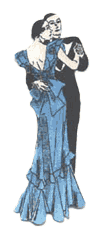 |
ROUND DANCING — CHOREOGRAPHED BALLROOMEDUCATIONAL ARTICLESMAJOR SECTIONS: Figures | Articles | Links | Alph. Index | Search | Home |
|
|
Adjust To Your Partner—Men, You Must Lead and Readby Harold & Meredith Sears A big part of dancing is adjusting to your partner as you go. This idea will not be news to the women, who are regularly reminded that they are expected to “follow” their man. These two quotes come from dance etiquette rules from the 1800s, referring to behavior both on and off the floor:
But a dance is not a one-way series of directives by the man to the woman; it is a two-way conversation between them. The "gentleman's province" really is to lead and to read his partner's movements and to adjust. For instance, the man is in charge of dance position—closed, semi, banjo—so he needs to adjust his steps as he dances to stay in good position. He mustn't slavishly dance the textbook steps, but should continuously read the woman's following movements and then adjust his steps to stay together. She too will make every effort to stay up to him at the hips and to step in response to his lead. She will follow, but he "follows" too.Let's think about dancing a Reverse Turn in Foxtrot. We might be in closed position facing line of dance. The man knows what to do. He turns left, stepping forward, steps side, steps back; back, side, forward. He thinks, I can do that. But this is not a solo performance. If he only dances his "proper" steps, the result will be rough and jerky. He must indicate his intentions (lead), he must sense her responses (read), and he must then adjust his subsequent steps based on that two-way conversation. The first step of the Reverse Turn is forward left, but he can't just move forward and step. It would push her over. Instead, lower a little into the right knee to indicate that we are beginning to dance. Begin a little left-face upper-body rotation to say that we'll be turning left. This begins the lead-and-follow conversation. Now we can step. He has prepared, and she is forewarned. He steps forward, rising, and she steps back. If she truly follows his movements, he will begin to take weight just a bit before she does, and this sequence will avoid bumps and trodden-on toes. For the second step, the woman simply brings her left foot to her right in preparation for her Heel Turn. The man steps forward and side right, stepping through the woman's left hip, turning her a total of 1/2. He dances through her left hip as though through a turnstile, and she turns in place, pivoting on her right foot. At the end of the beat, she simply changes weight to her left foot. He has moved with a side step, but she really hasn't. He is moving around the circumference of a small circle. She is simply turning in place at the center of that circle. And here the man must focus on the "reading" part of his lead. It is so easy to take that second step down line of dance and so pull her off her Heel Turn. So pay attention to where she is located, and do not dance away from her. Respect her position as the axle of this "turnstile," and adjust your step to stay in closed position. You may have to take a shorter step, one that is more forward than side—whatever you have to do to stay together. Don't just take your step. Dance together. Now comes the third step. She is passively rotating on her right foot. Once she has turned to face line of dance, she will take weight on her left. Men, you must pay attention to this sequence. The cue (Reverse Turn) may have told you to step back on your left foot at this point. The music or something deep within you might be telling you to step back. But you need to read your partner and hold that back step until she has changed weight. If you try to step back left before she has closed left, then she will have to quick-close in order to step forward right, and it will feel bumpy and jerky. If you sense her Heel Turn and weight change, then the figure will flow so much more smoothly and comfortably. Well, there is more to the Reverse Turn, but you get the idea. Lead, read, adjust, and only then lead some more. We can't just dance to the cues, or even to the music—we need to dance to our partner, too.
This article was published in Round Notes, CRDA, p.7, August/September 2008; and reprinted in Footnotes In the Round, LRDTA, 28-11:8–10, 11/2008; by Dixie Round Dance Council, 47-11:9, 12/2008; and by North Carolina Round Dance Association, p. 6, August 2009.
If you would like to read other articles on dance position, technique, styling, and specific dance rhythms, you may visit the article TOC. If you are not a member of DRDC, do consider joining. The group sponsors triquarterly weekends with great dancing and teaching, and the newsletter is one of the most informative available. Past DRDC Educational Articles archived here. Go beyond this site. Find other references on our Sources and Links pages.
|
 |
|
|
Page last revised